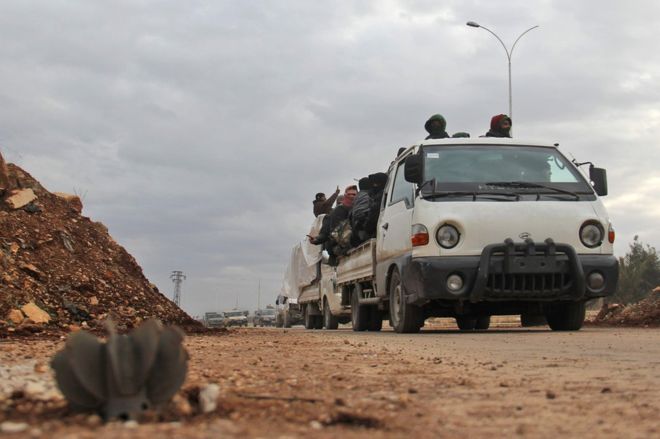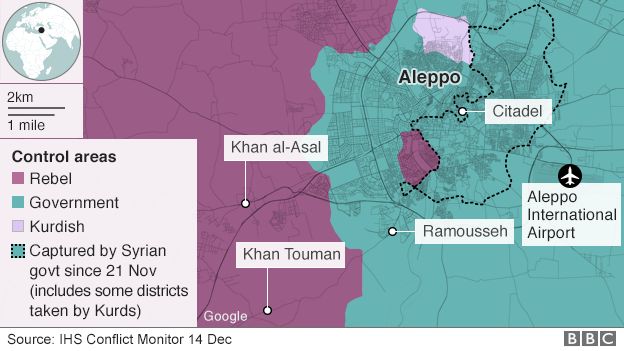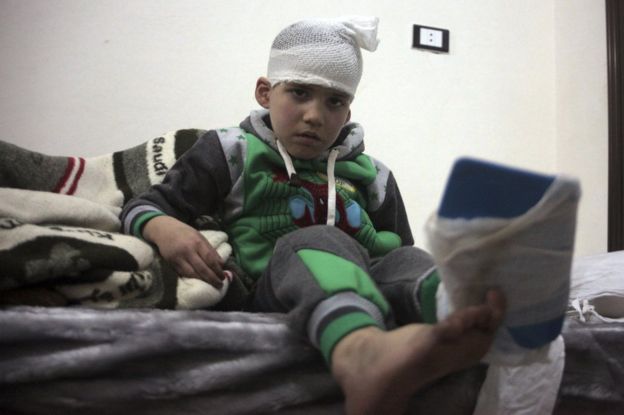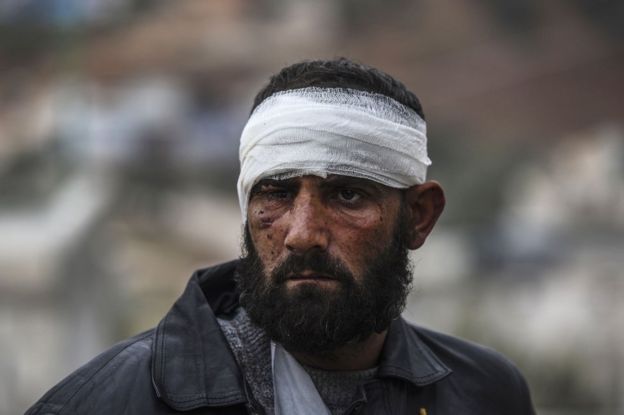

The evacuation of east Aleppo has been halted, with Syrian rebels accused of failing to respect a deal to lift their own siege of two pro-government towns.
At least 6,000 civilians and rebels are said to have left Aleppo, Syria’s largest city, since Thursday after the government recaptured most of the city.
Among the evacuees are at least 2,700 children, a UN agency reports.
But the UN believes tens of thousands of people remain trapped in east Aleppo and warns children there are in danger.
“Aleppo is now a synonym for hell,” UN Secretary-General Ban Ki-moon told reporters in New York, urging a resumption of the evacuation.
France is calling on the UN Security Council to ensure the operation is co-ordinated by international observers, with humanitarian aid allowed into the city and hospitals given protection.
Four years of vicious fighting in eastern Aleppo left thousands dead, destroyed hospitals and wiped out food supplies.
Meanwhile, there were new protests across the world, from Malaysia to Turkey, to condemn violence against Syrian civilians and show solidarity with the country’s opposition.
- What next for the evacuees?
- What’s happening in Aleppo?

Why did the evacuation stop?
Confusion reigned on Friday morning when the evacuation, which was taking place along corridors out of Aleppo towards rebel-held areas (Khan al-Asal and Khan Touman), was stopped.

 Image copyrightAFP
Image copyrightAFPRussia, a key ally of the Syrian government on the ground, said the evacuation was complete, with all rebels and their families having been evacuated. It put the number at more than 9,500.
However, Turkey contradicted this, saying many people still wanted to leave.
Speaking in Ankara, Turkish Foreign Minister Mevlut Cavusoglu said consultations were under way with Russia and Iran, another key ally of the Syrian government, as well as “elements on the ground”.
An unnamed Syrian official overseeing the operation told AFP news agency the evacuation had been suspended “because the militants failed to respect the conditions of the agreement”.
Under a deal brokered by Russia and Turkey, the rebels were meant to ease their siege of towns in Idlib province.
Reports suggest the biggest rebel group in Idlib, the Jabhat Fateh al-Sham jihadists formerly known as the Nusra Front, have now agreed to allow injured people to leave the towns, Foua and Kefraya, which are home to some 20,000 people.
Syrian state media also accused rebels in Aleppo of trying to smuggle captives and heavy weapons out with them as they left Aleppo.

Who is still trapped in eastern Aleppo?
The UN’s children’s charity Unicef says sick and wounded children are among the evacuees from east Aleppo, some of whom left without their parents.
 Image copyrightAP
Image copyrightAP Image copyrightAP
Image copyrightAP Image copyrightAFP
Image copyrightAFP“However, hundreds of other vulnerable children, including orphans, remain trapped inside that part of the city,” it added.
“We are extremely concerned about their fate. If these children are not evacuated urgently, they could die.”
On Thursday, the UN envoy to Syria, Staffan de Mistura, had put the number of people remaining in east Aleppo at 50,000.
- How Srebrenica’s survivors view Aleppo
- Russia hails ‘victory over terrorism’
- Global solidarity over Aleppo

Is there any sign of peace in Syria?
Government forces have captured almost all of the rebel-held territory in eastern Aleppo, with the help of Russian air strikes. But the conflict in Syria is far from over.
 Image copyrightADEM ALTAN
Image copyrightADEM ALTAN Image copyrightREUTERS
Image copyrightREUTERS Image copyrightAFP
Image copyrightAFPUS Secretary of State John Kerry has accused the Syrian government of carrying out “nothing short of a massacre” in Aleppo.
Syria and Russia have repeatedly denied targeting civilians in eastern Aleppo.
Russian President Vladimir Putin called for all sides to agree to a complete nationwide ceasefire on Friday.
In another development on Friday, Syrian state media report that a girl aged between seven and nine, wearing a bomb belt, blew herself up at a police station in the Midan district of the capital, Damascus.
Three police officers were reportedly injured in the explosion.
[Source:-BBC]




